IPL 2012
Cricket +
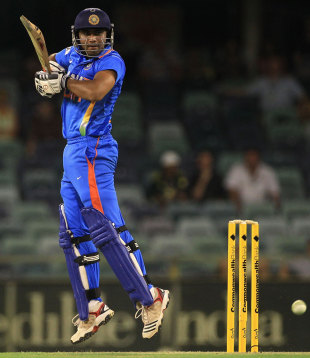
| |||
Related Links
Players/Officials: Srikkanth Anirudha | Dwayne Bravo | MS Dhoni | Ben Hilfenhaus | Ravindra Jadeja | Suresh Raina
Series/Tournaments: Indian Premier League
Teams: Chennai Super Kings | India
| |||
Big picture
Runners-up, semi-finalists, champions, champions. Thus reads Chennai Super Kings' record across the first four seasons of the IPL. They have been the most consistent and successful team in the league by far, and are the most settled side as well, after retaining most of their squad in last year's shuffle.
That they have a settled line-up was reflected in the 2012 auction, when they were willing to spend their entire purse on a single acquisition: Ravindra Jadeja. They were involved in a fierce bidding war for Jadeja with Deccan Chargers, and eventually beat them in the tie-breaker. Even so, Super Kings cannot afford any complacency and coach Stephen Fleming knows it. "There is a fine line between finishing first or indeed missing out on the finals," he said in an interview on the franchise's website. They have tread that line on several occasions - in 2008 and 2010 Super Kings faced a must-win situation in their last league game to make the semis, while last year they almost complicated things for themselves by delaying their launch till the very last moment in a stiff chase in the play-off against Royal Challengers Bangalore.
In 2011 the batting was typically solid, with MS Dhoni, Suresh Raina, Michael Hussey, S Badrinath and M Vijay all aggregating in the vicinity of 400 runs. R Ashwin, expectedly, led the team's bowling charts with 20 wickets at 19.40 apiece. If Super Kings have a weakness, though, it is on the fast-bowling front. Their opponents have often got off to fliers against the quicks, before Dhoni has applied the squeeze and invariably turned the match with the spinners. On that count, they will be happy to have the services of Australia's Ben Hilfenhaus this time around. When he arrives from the West Indies, he should form a solid partnership with Doug Bollinger, Super Kings' pace spearhead over the last two seasons.
Off the field, Super Kings have been at the centre of several controversial issues - including a possible conflict of interest with BCCI president N Srinivasan also managing India Cements, the owners of Super Kings - but their on-field performance has been strong enough to steal the headlines and deflect negative publicity.
Key players
The Dhoni-Raina combine: For Super Kings, when it comes to key performers, it's hard to look beyond MS Dhoni and Suresh Raina. The pair has formed the backbone of the team since the inaugural IPL, with Raina not missing a single match across seasons and captain Dhoni missing just three of Super Kings' 62 games. Dhoni, with an average touching 40, has scored 1425 runs, while Raina is the leading run-getter in the IPL's short history with 1813 at 36.26. Add to that Raina's tidy offspin and electric fielding, and Dhoni's tactical nous on tweaker-friendly tracks, and you know why Chennai paid big bucks to retain them last season.
Dwayne Bravo: Super Kings have a preference for allrounders. The squad is always packed with them, one being Bravo, who Super Kings signed last year. Coming off a long break due to an ankle injury, Bravo was picked in the West Indies squad for the limited-overs games against Australia earlier this month, and took up new-ball duty in the ODIs. If he could do the same, effectively, for Super Kings, it would add better balance to the side. That, plus a few timely cameos down the order, and he could push Albie Morkel for the No. 1 allrounder's spot in the XI.
Big names in
Ravindra Jadeja: The only new signing in a well-established squad, Jadeja, as an allrounder, fits Super Kings' preferred mould. Unlike the overseas allrounders, though, he gives Super Kings a spinning option. Presumably, he has always enjoyed the backing of his captain, Dhoni, but he might still feel the pressure to perform after being the biggest buy at the 2012 auction.
Ben Hilfenhaus: A potential answer to Super Kings' fast-bowling worries. Hilfenhaus was meant to play the 2011 IPL for Chennai, but missed out due to injury. Prior to that, he had had a poor showing in the 2010-11 Ashes, meaning he was out of the Australia team. When he returned, after almost a year, he hit top form - he led the wicket-takers' charts in the Australia-India Test series, and returned to international limited-overs cricket with a five-for in the tri-series that followed.
Big names out
Tim Southee: The New Zealand quick replaced the injured Hilfenhaus in the squad last season, and began impressively: his inch-perfect final-over yorkers won Super Kings' the tournament opener against the Kolkata Knight Riders by two runs. Thereafter though, he tapered off a bit, finishing with four wickets from five games at 41.50 apiece. He went unsold at the 2012 auction.
Below the radar
Anirudha Srikkanth: A hard-hitting opening batsman, Anirudha was the Man of the Match in last year's opener against Knight Riders. Once Michael Hussey arrived though, he, expectedly, was sidelined. This year, fitness and availability issues could mean that Anirudha has a chance to open the innings with M Vijay early in the tournament once again. He showed decent touch in the recently-concluded domestic one-day competition, the Vijay Hazare Trophy, scoring three half-centuries in five matches for Tami Nadu. Super Kings will want more of the same.
Availability
Opening batsman Abhinav Mukund twisted his left ankle during the pre-tournament training camp on Sunday, and will be out of action for ten days. Among the overseas signings, Doug Bollinger, Albie Morkel, Faf du Plessis, Dwayne Bravo and George Bailey are all available from the start of the tournament. Offspinner Suraj Randiv is expected to arrive on April 8, following the conclusion of the Sri Lanka-England Tests, and Hilfenhaus and Hussey on April 30, after the West Indies Tests. Sri Lanka seamer Nuwan Kulasekara, who is recovering from a hamstring strain, is scheduled to join the squad on April 10.
2011 in a tweet
They came, they saw, they scrapped, they conquered … again.Indian Premier League 2012
Royal Challengers hope for Gayle magic
Cricket +
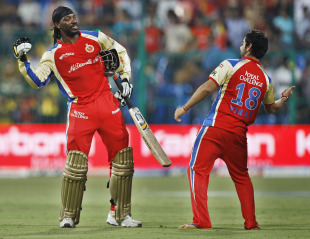
| |||
Related Links
Players/Officials: KP Appanna | Tillakaratne Dilshan | Chris Gayle | Virat Kohli | Muttiah Muralitharan | Vinay Kumar
Series/Tournaments: Indian Premier League
Teams: India | Royal Challengers Bangalore
| |||
Big picture
If one had to fix the 'chokers' tag to an IPL team, it would have to be on Royal Challengers Bangalore. They've reached two IPL finals and a Champions League final, finishing runners-up in all three. Faltering at the biggest stage has become a habit for a team very capable of winning titles consistently. They've got balance, big hitters, stars and a penetrative bowling attack. The squad also has a mixture of youth and experience.
The team has come a long way from the 'Test team' of 2008. Chris Gayle leads a power-packed top order, followed by Tillakaratne Dilshan, AB de Villiers and India's latest sensation, Virat Kohli. Gayle was retained this year for an official amount of US$550,000, while the two big purchases were Vinay Kumar (US$1 million) and Muttiah Muralitharan (US$ 220,000). Andrew McDonald, the Victoria allrounder, was bought from Delhi Daredevils during the transfer window. Zaheer Khan, if fit, will be a valuable asset to the bowling.
Royal Challengers began with a win last year but lost the next three. The fifth was abandoned, but they made the next seven games their own. In one of those games, against Kochi Tuskers Kerala, Gayle smashed 37 off one over, the hapless bowler being Prasanth Parameswaran. Gayle made Bangalore the team to watch, and it was his hitting that led them to the top of the points table. However, they lost the first qualifying final, meaning they had to win their second qualifier against Mumbai Indians to meet Chennai again in the final. In the end, they were no match for Chennai, who batted them out of the game and dismissed Gayle for a duck.
Key players
Chris Gayle - The 'hired gun' from West Indies, probably the most sought-after Twenty20 player, has committed himself to the full season. He has been busy, though, sorting out his differences with the WICB. He's expected to be fit from the groin niggle that he had sustained during the Bangladesh Premier League.
Virat Kohli - No target is beyond reach for Kohli, who's proving to be a sensation during chases. He is clearly the best thing to come out of the rubble of Australia 2011-12. He's in the form of his life, emerging as one of the most dangerous limited-overs batsmen in the world in the last year and a half. Along with Gayle, Kohli would form a destructive pair.
Big names in
Vinay Kumar - The India fast bowler was bought back by his native Bangalore for a million dollars, one of the biggest buys at the auction. He became a changed bowler during the limited-over games in Australia, running in hard and cranking up his pace. Kumar needs to work more on his death bowling though.
Muttiah Muralitharan - Like Gayle, the former Sri Lanka offspinner is another Twenty20 player available for hire the world over. He was bought for US$220,000 from the defunct Kochi Tuskers Kerala. Captain Daniel Vettori couldn't have asked for a better spin partner.
Below the radar
Vijay Zol - The 17-year-old smashed a remarkable unbeaten 451 for Maharashtra Under-19s against Assam Under-19s in Nasik last year. His knock even caught Virender Sehwag's attention. He has since played only one match for the Maharashtra senior side, but his lack of experience at the highest level didn't stop Bangalore from signing up an unknown.
KP Appanna - The left-arm spinner could be Bangalore's first-choice spinner if Murali doesn't play. He was Karnataka's leading wicket-taker in the Syed Mushtaq Ali Twenty20 tournament with ten wickets.
Availability
Dilshan is expected to miss the opening game, due to the second Test between Sri Lanka and England. The rest of the squad is free from international commitments.
IPL 2012
Mumbai Indians are strong, but will results follow?
Cricket +
Big picture
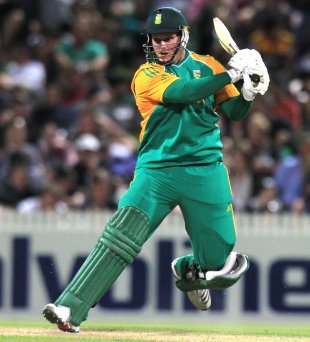
| |||
Chennai Super Kings may be two-time defending champions but Mumbai Indians look like the team to beat in IPL 2012. It took a Chris Gayle special to keep them out of the final last season and the franchise has since added to its already formidable squad through astute transfers and auction buys.
One of Mumbai's biggest weaknesses lay behind the stumps, so they acquired Dinesh Karthik, one of India's better keepers and an aggressive batsman. They strengthened their bowling with the additions of RP Singh and Pragyan Ojha, two of the top four highest wicket-takers in the IPL; and when Andrew Symonds abruptly retired, they seized the opportunity to sign the record-breaking South Africa opener, Richard Levi, to partner Sachin Tendulkar at the top of the order, thereby solving another of their problems.
The team will also be brimming with confidence after winning the 2011 Champions League T20 despite missing Sachin Tendulkar and Davy Jacobs, their first choice opening pair. Under the gritty captaincy of Harbhajan Singh - who will lead the team here as well, after Tendulkar passed on the reins* - Mumbai pulled off one unlikely win after another before toppling Royal Challengers in the final.
With such an abundance of talent, the biggest challenge for Mumbai will likely be deciding whom to leave on the bench. Kieron Pollard and Lasith Malinga, the Champions League Man-of-the-Tournament, are automatic selections. If Levi opens alongside Tendulkar, that leaves just one more spot for a foreign player from among the likes of Clint McKay, Herschelle Gibbs, Mitchell Johnson, James Franklin and Thisara Perera. As problems go, it's one every franchise would wish they had.
A perennial favourite, Mumbai failed to win the IPL in the first four years, coming closest in 2010, when they lost the final to Super Kings. This season could well be the year they end their drought.
Key players
Sachin Tendulkar was Mumbai's leading run-maker by a considerable distance in 2011 and the third highest in the league overall. With the chase for his 100th hundred over, sans the responsibility of captaincy and with Richard Levi at the other end potentially providing the fireworks, Tendulkar can concentrate on building his innings and providing the platform from which the team's big hitters can let loose.
The top two wicket-takers last season were Mumbai fast bowlers Lasith Malinga and Munaf Patel. The pair not only took a combined 50 wickets, but they were hard to score off, boasting economy rates of 5.95 for Malinga and 6.58 for Munaf. If they can repeat those kinds of performances, Mumbai will be very hard to beat.
Big names in
Richard Levi: Mumbai have struggled to find an opening partner for Tendulkar in the IPL, with a number of contenders being rotated in and out of the side over the past four years. Two months ago, Levi bludgeoned his way into the record books for South Africa against New Zealand in Hamilton with the fastest century in Twenty20 cricket. On the batting-friendly pitches of the subcontinent, his pyrotechnics could be the final piece in Mumbai's quest for the title.
Big names out
Andrew Symonds: The former Australia allrounder announced his retirement from professional cricket earlier this year. Mumbai are unlikely to miss him much, though, given the quality of the players they have added through the trading window and the auction.
Below the radar
Suryakumar Yadav: The 21-year-old had a breakout season for Mumbai in the Ranji trophy, scoring 754 runs at an average of 68.54 and a strike rate of 85.00. His tour de force was the 200 he made against Orissa, which came from just 232 balls and included 28 fours and a six. Given a chance, he has the potential to inflict serious damage on an opposing bowling attack.
Availability
None of Mumbai's players have international conflicts. They will be able to draw on their full squad for the entire tournament.
IPL 2012
Tendulkar steps down as Mumbai Indians captain
Cricket +
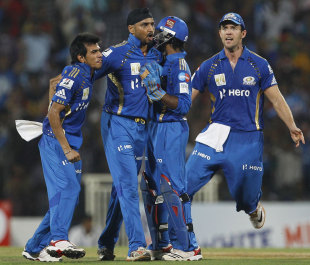
| |||
Related Links
Players/Officials: Harbhajan Singh | Sachin Tendulkar
Series/Tournaments: Indian Premier League
Teams: India
| |||
Sachin Tendulkar has stepped down as Mumbai Indians captain ahead of the IPL 2012 season-opener against Chennai. Harbhajan Singh, who was Tendulkar's deputy, has been appointed captain by the franchise after Tendulkar cited needing a "break'' in leadership duties as the reason.
"Sachin Tendulkar, in discussion with the management of Mumbai Indians, has decided to hand over the responsibilities of captaining Mumbai Indians in season five of the IPL to ace offspinner Harbhajan Singh," a media release from the franchise stated.
Tendulkar said that he had discussed the matter with the owners of the franchise before taking the decision. "At this point of time, I feel I need a break from the responsibility of captaincy of the Mumbai Indians," Tendulkar was quoted as saying in the release. "After due consideration, I discussed my intention to hand over the captaincy of the team to Harbhajan Singh, with Mukeshbhai [Ambani] and Nitabhabhi."
In the four years Tendulkar was at helm, the best result Mumbai achieved was in the 2010 edition of the tournament, when they finished as runners-up to Chennai Super Kings.
Harbhajan, who led Mumbai to the Champions League T20 title last year, was the automatic choice to take over the leadership mantle. Incidentally, Tendulkar sat on the bench through that victorious campaign, as he was recuperating from a toe injury he picked up during the England tour last August.
Though Harbhajan's bowling form has been patchy, he has found success as a captain. After leading Mumbai Indians to the Champions League title, he led the India Green team in the Challenger Trophy, top-scoring for his side in the tied final and picking up 3 for 37. Recently, he led Punjab Twenty20 side to the final of Syed Mustaq Ali Trophy, which they lost to Baroda.
IPL 2012
Time for Pune Warriors to make on-field headlines
Cricket +
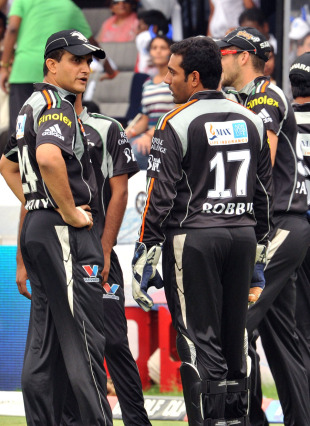
| |||
Big Picture
In its short existence, Pune Warriors, the youngest and costliest IPL franchise, has been in the news for various off-field reasons. The unavailability of their star player Yuvraj Singh due to illness precipitated a crisis in Indian cricket as the franchise owner, the Sahara Group, pulled out of its sponsorship of the national team and also put the franchise up for sale after disagreements with the BCCI. After confusion, uncertainty and negotiations, they decided to stay on as both, India team sponsors and Warriors owners.
Warriors didn't have much to show for their debut season last year. They finished second from the bottom and had a disappointing run of seven straight losses. Their batsmen failed to fire and they won only when their bowlers were able to restrict the opposition and set up modest chases. They were the only franchise whose 'home' stadium was anything but. Situated in Nerul, adjacent to Mumbai on the highway that leads to Pune, the DY Patil Stadium was the Warriors' base.
A spanking new stadium beckons this season. The Sahara Stadium on the outskirts of Pune will be the Warriors' new and permanent home. Getting to the ground will be an achievement for Pune residents, though.
Warriors suffered last season from the failure of their top order to fire, leaving too much to do for the likes of Yuvraj and Robin Uthappa. Yuvraj came in too late on many occasions, with Warriors already out of the game. That cannot be improved upon this season, with Yuvraj's absence.
Sourav Ganguly can be expected to be tactically better as captain than Yuvraj was, but it would be unrealistic to expect him to have a similar impact with the bat. Twenty20 batting has not been Ganguly's strength. A career strike-rate of 108.64 and an average of 27.00 in the format reflect that. Can Ganguly's leadership inspire Warriors? That they have a meatier squad this time should help. Tamim Iqbal, Marlon Samuels, Angelo Mathews and Luke Wright add lots of power to the batting. These additional resources make the bowling look thin in comparison, but on the evidence of last year, that wasn't the bigger problem area for Warriors.
Key players
Warriors' $2.1m signing, Robin Uthappa, had an average tournament last year with 264 runs from 14 games. With Warriors not being able to get a top wicketkeeper after losing Tim Paine to injury, Uthappa will have to continue shouldering the additional task of keeping wicket. He has had a decent run with the bat this domestic season and Warriors will hope he can carry that form into the IPL.
Rahul Sharma is back to the tournament that launched him into the Indian team. Sixteen wickets at an economy-rate of 5.46 with his unconventional, skiddy and bouncing legbreaks made the Indian selectors mark him as one with potential. This season will be different. Rahul will be expected to perform as an India player. It will be a test.
He might be in the news for the wrong reasons at the moment, but last year, Jesse Ryder was Warriors' second-highest run-getter with 292 from 13 games with a strike-rate of 148.22, the highest for his side. He has cut short his break from cricket to play in the IPL and has arrived with a sports psychologist in tow. He looks to be in the mood to prove a point. Far away from the scrutiny back home in New Zealand, if he is able to do that, Warriors would have gained almost as much as Ryder will.
Big names in
Just imagine the kind of following Kolkata Knight Riders would have generated if they had Ganguly, Shakib Al Hasan and Tamim Iqbal playing together. It would probably have been the franchise with the biggest following, with West Bengal and Bangladesh combining to form a massive fan base. Warriors needed someone like Tamim at the top. For all his newfound penchant of playing the long innings in ODIs, Tamim can explode at will, and when he is in full flow, there are few better sights in the game. Authoritative cover drives and graceful clips, Tamim has all the strokes at his disposal.
Marlon Samuels was the first player to be signed by Warriors after they had boycotted the IPL auction earlier this year. Samuels has been around for a long time and is a powerful batsman as well as an underrated bowler. With Angelo Mathews not being able to bowl at the moment, Samuels' role in the side gains importance.
Michal Clarke is an interesting acquisition. He has never looked comfortable in this format with a strike-rate of 108.85 in 40 Twenty20s and had given up the format earlier. His last Twenty20 was in October 2010. He can be a useful bowler with his slow left-armers and is a sharp fielder but just what value he will add with the bat to a line-up boasting many power-hitters remains to be seen.
Big names out
Warriors have lost capable allrounders Mitchell Marsh and James Hopes, and batsman Graeme Smith, to injury. The biggest loss, of course, has been that of Yuvraj, their best batsman and third-highest wicket-taker last year.
Below the radar
The experienced South African fast bowler Alfonso Thomas was a key component of Warriors' attack last year with 11 wickets at an economy-rate of 7.71. The 35-year-old veteran has played domestic cricket all around the world and while he is not a big name, his experience will be required.
Availability
Samuels' availability will depend on whether he is part of the West Indies Test squads for the home series against Australia in April and the upcoming tour of England in May. Clarke will miss the first half of the IPL while he leads Australia against West Indies.
2011 in a tweet
A false dawn, losses, more losses and a helpless Yuvraj. Deserved to bring up the rear of the table
A day in the life of a physio
The long and packed schedule of the IPL isn't just gruelling for the players but also the support staff who look after them
Cricket +
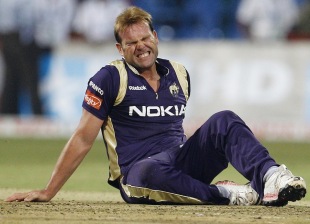
| |||
Related Links
Players/Officials: Andrew Leipus
Series/Tournaments: Indian Premier League
Teams: India | Kolkata Knight Riders
| |||
"What is it like working for an IPL team?" is a question I get asked a lot. Following the last column, in which I introduced the topic of sports medicine, it seems fitting to describe an average day of a physio on tour.
My most recent stint as a cricket physio has been with the Kolkata Knight Riders. During the IPL we have a number of different daily scenarios to plan for, and these can be broadly divided into: camp, match day, travel day, practice day and recovery day.
Preparatory Camp
Ideally, every IPL team wants its players arriving for the tournament with plenty of time to get accustomed to local conditions, get over jet lag, and to get to know the rest of the team. This applies not only to players but to the coaching and support staff as well.
Ideally, every IPL team wants its players arriving for the tournament with plenty of time to get accustomed to local conditions, get over jet lag, and to get to know the rest of the team. This applies not only to players but to the coaching and support staff as well.
Most physios like to start the preparatory camp with medical screenings. The threat of litigation is very real in professional sport, so it is important to assess each player on his arrival for a number of details, with his current medical/fitness status being the main concern. In a squad of up to 30 players these screenings take up a lot of time. It is critical to assess a player's current condition because while he might not have an injury on arrival, a lack of basic physical fitness in Twenty20 cricket can predispose him to one. This is obviously a liability to the team from a performance and availability perspective.
Screenings also identify potential problems, which, if addressed early, could prevent injuries. IPL teams pay fat salaries to players and have every right to expect them to arrive and stay in top physical condition. Adrian Le Roux, our legendary fitness expert, likes to measure a number of physical fitness parameters, such as the yo-yo intermittent recovery test for testing repeatability of efforts, and skinfolds measures for an estimate of body fat levels. This information supports my injury assessments.
Practice days
I start a standard practice day by organising and prioritising a treatment list. I'll do a recce at breakfast of players who have been undergoing treatment. Then it's a matter of guessing how much time I need with each player and scheduling treatment around other team commitments such as practice. Some treatments are relatively quick, taking no more than 20 minutes, whereas with those who have multiple injuries or niggles, I can spend over an hour. The treatment room is often a hive of activity as players hang out and chat whilst waiting for their turn on the table. When there are so many players it is often challenging examining them all in the available time.
I start a standard practice day by organising and prioritising a treatment list. I'll do a recce at breakfast of players who have been undergoing treatment. Then it's a matter of guessing how much time I need with each player and scheduling treatment around other team commitments such as practice. Some treatments are relatively quick, taking no more than 20 minutes, whereas with those who have multiple injuries or niggles, I can spend over an hour. The treatment room is often a hive of activity as players hang out and chat whilst waiting for their turn on the table. When there are so many players it is often challenging examining them all in the available time.
The thing about practice days in the IPL is that since all the matches are under played under lights, it makes sense to have most practice sessions under similar conditions. But this is not always the case because of the cost involved in switching on the stadium lights. Lights also attract trillions of flying insects and these can become a real issue, with various mosquito-borne diseases being endemic. It doesn't seem to bother local players but the foreign ones are justifiably cautious. I go through a lot of repellent.
At practices, I need to be present to work with anyone who needs me - from managing acute injuries, strapping bodies, mobilising joints or testing whether the player is ready to return. Many injuries also occur during practice and need to be managed correctly, and various medical interventions tested before match situations. Often I need to try various strapping techniques to obtain the best functional result. The first practice at a new ground is also an opportunity to evaluate the local facilities, meet the doctors, assess the medical room and emergency plan, and even review the food provided.
| Match day doesn't end with the last ball. Injury and recovery management begin immediately after the players come off the field. There is also frequent drug-testing, usually a lengthy process, since you wait until a suitable urine sample can be produced. I have returned to the hotel after 3am on more than one occasion | |||
Match day
Due to the late start and finish times of IPL matches, players often come down late for breakfast or miss it entirely. If this means a good night's sleep then it isn't a bad thing. The players' absence gives me the opportunity to catch up on administrative work or to schedule any doctors' or radiology visits. The post-lunch period is reserved for fine-tuning the playing squad, with individual appointments either in the treatment room or in the gym for specific rehabilitation. At some stage in the afternoon, there will be a team meeting to discuss the match strategy and team composition. We aim to allow approximately one and a half hours at the ground before the start of the match. The players like to use this time to unpack their kitbags, have a snack, wander onto the field to discuss the wicket, and to generally calm the nerves. Warm-ups begin about an hour before start. I use this time to set up in the medical room, prepare ice packs and stock the run-on medical bag before proceeding to work with players who need my assistance. One particular player needs specific ankle-taping that takes me 15 to 20 minutes to complete, so I usually do such work at the hotel.
Due to the late start and finish times of IPL matches, players often come down late for breakfast or miss it entirely. If this means a good night's sleep then it isn't a bad thing. The players' absence gives me the opportunity to catch up on administrative work or to schedule any doctors' or radiology visits. The post-lunch period is reserved for fine-tuning the playing squad, with individual appointments either in the treatment room or in the gym for specific rehabilitation. At some stage in the afternoon, there will be a team meeting to discuss the match strategy and team composition. We aim to allow approximately one and a half hours at the ground before the start of the match. The players like to use this time to unpack their kitbags, have a snack, wander onto the field to discuss the wicket, and to generally calm the nerves. Warm-ups begin about an hour before start. I use this time to set up in the medical room, prepare ice packs and stock the run-on medical bag before proceeding to work with players who need my assistance. One particular player needs specific ankle-taping that takes me 15 to 20 minutes to complete, so I usually do such work at the hotel.
Any fitness issues might also need to be resolved during this time, and decisions must be made on the status of the player before the toss. Such decisions are better made before match days, but because of the packed itinerary we're sometimes forced to take a last-minute call after putting the player through a battery of fitness tests.
One night on arriving at the ground, one of our key foreign players tweaked his upper back getting out of his seat on the team bus. I recall working frantically to settle it down as best as possible and then test his "fitness" before the toss. He said he'd be okay and decided to play. Fortunately in this case, he loosened up as the match progressed and woke up feeling okay the next morning. This is just one of the challenges of working in the IPL.
Throughout the match we must be ready for any medical or non-medical situation. The usual suspects include impact injuries, muscle strains, joint sprains, cramping, headaches, concussion, bugs in the eyes, nausea, and split finger webbing, to name a few. But we're also frequently asked to cut shoe toe-boxes, provide superglue (to repair bats) or cover inappropriate logos with tape. It is surprising how many players do not prepare themselves more professionally. One has to be prepared for as many eventualities as possible during a match.
Match day for me doesn't end with the last ball. Injury and recovery management begin immediately after the players come off the field. We encourage them to use ice baths and cryotherapy, and most of them are professional enough to know when they need it. There is also frequent drug-testing, usually a lengthy process since you wait until a suitable urine sample can be produced. I have returned to the hotel after 3am on more than one occasion.
Travel day
The team management meets at the start of the season to discuss the flight schedule so we can optimise player recovery. Early-morning flights after a match are avoided wherever possible to allow players time to sleep. Some coaches feel a travel day is not strictly a full recovery day but it does allow time for a 30-minute recovery pool-and-stretch session before we fly. A later flight also gives the players an opportunity to get medical treatment, a massage, or to squeeze in a gym or rehab session.
The team management meets at the start of the season to discuss the flight schedule so we can optimise player recovery. Early-morning flights after a match are avoided wherever possible to allow players time to sleep. Some coaches feel a travel day is not strictly a full recovery day but it does allow time for a 30-minute recovery pool-and-stretch session before we fly. A later flight also gives the players an opportunity to get medical treatment, a massage, or to squeeze in a gym or rehab session.
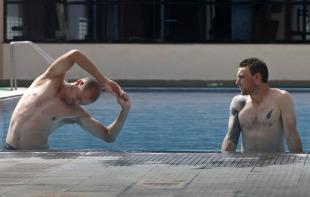
| |||
If a pool session isn't possible before leaving, we usually try to sneak one in immediately after arriving at the new hotel. Soon after arriving, I check out the hotel's gym and see what equipment is available, for it differs from place to place. A rehab programme in one gym might need to be modified to suit different equipment in another. Then it's time to set up and start planning treatment times again. As funny as it seems, players often don't come forward with injury information, not because they want to hide it but because they might consider it insignificant.
Recovery day
The IPL is a hectic tournament. Lots of travel, training, matches and practice. A recovery day is a complete day off for the players from all team commitments. T20 might not be the most physically tiring form of cricket but the length of the IPL and the number of matches can get mentally tiring.
The IPL is a hectic tournament. Lots of travel, training, matches and practice. A recovery day is a complete day off for the players from all team commitments. T20 might not be the most physically tiring form of cricket but the length of the IPL and the number of matches can get mentally tiring.
For the physio, recovery days are opportunities to work intensively with the injured. It also means we don't get days off throughout the tournament. But that's the IPL.
IPL 2012
Ryder to play IPL with support structure
Cricket +
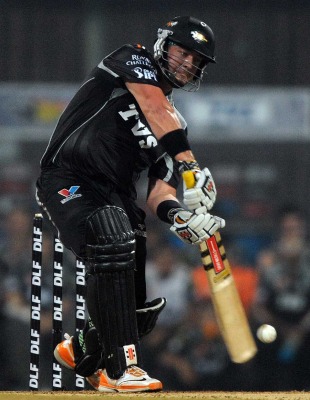
| |||
Related Links
News : Ryder takes indefinite break from cricket
News : Ryder testing patience - Wright News : Ryder, Bracewell dropped for breaking protocol
Players/Officials: Jesse Ryder
Series/Tournaments: Indian Premier League
Teams: New Zealand | Pune Warriors
| |||
Jesse Ryder, the New Zealand batsman who had taken an indefinite break from cricket to resolve personal issues, will play for his IPL franchise Pune Warriors in the fifth season of the league, beginning on April 4. Ryder will be supported in India by his manager Aaron Klee and clinical psychologist Karen Nimmo.
"Jesse has been making steady progress over the past few weeks. While the IPL has clear challenges, and is a big step, I believe he's ready to take it," Nimmo said. "Cricket is Jesse's job and what he's good at, so I was keen to see him return to the game as soon as practical, but only with the right structures in place."
Klee said Ryder was going to significant extents and expense to overcome his issues, and that their planning of his recovery was thorough. "Karen is travelling to India the day after Jesse and will continue her work with him there while I'll be going over a little later to carry that work on," Klee said. "The franchise has been wonderful and Jesse is desperate to perform on and off the field, and get his career back on track.
"We are also very grateful for the support of New Zealand Cricket [NZC] and Cricket Wellington for their assistance and support. Also, Heath Mills [New Zealand Cricket Players Association chief] has been incredible in his support as always."
NZC chief executive David White was supportive of the move. "It's really positive that Jesse has reached the point where here is ready to play competitive cricket again," he said. "He has clear expectations from NZC in terms of what is required from him to make a return to international cricket and playing in the IPL is a good first step. We are proud of the progress he has made and we will continue to support him through what has been a tough time."
On March 8, Klee had issued a statement saying Ryder had pulled out of Wellington's squad for their Plunket Shield match against Northern Districts and had not decided when he would make himself available again. The announcement came a week after Ryder was dropped from the New Zealand squad for the third ODI against South Africa for breaking team protocol, and then left out of the Test series as well.
After the defeat in the second ODI against South Africa, Ryder, along with Doug Bracewell, went to a hotel and became involved in an argument with a patron. "Team protocols dictate that players who are rehabilitating from injury should not consume alcohol and unfortunately both players went to a Napier hotel following the conclusion of the match," NZC had said in a release. "Also, while at the hotel both players verbally reacted to taunts from a member for the public."
The incident was the latest of Ryder's several indiscretions. In August 2010, Ryder was fined for "intoxicated and rowdy" behaviour at a hotel during an indoor cricket tournament and he said he had feared for his careerwhile NZC was investigating the incident. The most serious of Ryder's indiscretions was in 2008, when he put his right hand through a glass window during a late-night session at a Christchurch bar. In January 2009, NZC said Ryder had given up alcohol after another incident, which resulted in him missing an ODI against West Indies.
IPL 2012
Tamim signs for Pune Warriors
Cricket +
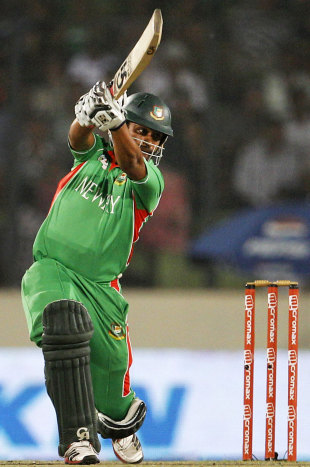
| |||
Related Links
| |||
Pune Warriors have signed up Bangladesh batsmanTamim Iqbal, filling all their overseas slots for the coming season. Tamim, whose signing was formalised on Wednesday, became the eleventh overseas player for the Warriors and their second signing this week after Australian captain Michael Clarke.
Tamim and the franchise management, led by their captain Sourav Ganguly, had been involved in talks for the past week. He joins Shakib Al Hasan as the second Bangladesh player in this year's IPL, and the fifth from that country in the tournament overall.
"I can gain a lot of experience by playing with greats like Sourav Ganguly and Michael Clarke. I like to talk a lot about cricket so I think I am lucky to be playing with them and look forward to learn new things," Tamim told ESPNCricinfo.
"It'll be an extra boost, so it is very important that I do well. More importantly, just like Shakib opened the door for me, I would want that with my inclusion in the IPL, it will let other players from my country to play in this competition.
"With the T20 World Cup coming up this year, it will be a big opportunity for me to perform in the format," Tamim said.
Tamim would look to carry his form into the IPL - he hit four half-centuries in the recent Asia Cup - given his failure during the Bangladesh Premier League last month where he only played two matches for the Chittagong Kings and scored only eight runs.
Indian Premier League 2012
Chargers bank on batting, fresh faces
Cricket +
Big picture
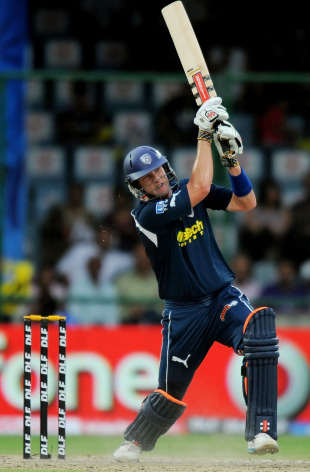
| |||
Related Links
Players/Officials: Ashish Reddy | Darren Bravo | Ishank Jaggi| Amit Mishra | Kumar Sangakkara | Ishant Sharma | Cameron White
Series/Tournaments: Indian Premier League
Teams: Deccan Chargers | India
| |||
Deccan Chargers have been one of the least controversial teams in the IPL. Unlike other franchises, they have been relatively free of court cases, litigations, suspensions, disputes, off-field dramas. They've had their share of success, winning the 2009 IPL after a shoddy opening season. They reached the semi-finals in 2010 with the same set-up.
However, they fell apart again last year when the teams were reshuffled. They finished seventh, failing to qualify for the knockouts. The side lacked the dynamism of Adam Gilchrist, who scripted the remarkable turnaround in 2009. With him went other star performers in Andrew Symonds, Rohit Sharma, Herschelle Gibbs and RP Singh. The new-look squad was captained by Kumar Sangakkara, and assisted by the Australian Cameron White, who had a poor season. Deccan ended the first-half of their campaign last year with three wins and four losses. They ended the tournament with three consecutive wins but it wasn't enough to progress. Still, six wins and eight defeats highlighted an ordinary season for the former champions.
They begin this edition as one of the weaker teams, on balance. Much would depend on the foreign players and Sangakkara will have to lead the way. There were no million-dollar buys in the auction, with their costliest signing being Parthiv Patel for US$650,000. They did, however, stretch Chennai Super Kings in the bid for Ravindra Jadeja. Deccan were edged out in the secret tie-breaker (locked at $2million). Their coach, Darren Lehmann, says batting will be their strength this year. He says that that the number of fresh faces in the squad could work to their advantage because the opposition wouldn't know what to expect. Looking back at 2011, he wants the team to start well this time.
Key players
Cameron White: The former Australia Twenty20 captain didn't have a memorable campaign last year, scoring only 104 runs in six innings. He didn't have a great time in the Big Bash League either, with just 55 runs from eight games. He needs to turn it around to justify his purchase.
Amit Mishra: The absence of Pragyan Ojha hands the lead-spinner role to Mishra. He was the leading wicket-taker for Deccan last season, with 19. Dropped from the Indian team, this IPL could be the platform to stage a comeback.
Big names in
Darren Bravo: The stylish West Indies batsman was one of the franchise's key overseas signings, for $100,000. His form during West Indies' visit to India stood out, as much as his similarity to Brian Lara. However, he hasn't been in the best of form with West Indies of late.
Big names out
Ishant Sharma: The fast bowler will be sitting out of the IPL to recover from an ankle surgery. He put off the surgery for almost a year, but decided to go ahead with it after the Australia Tests. His franchise will miss him, but it could be beneficial for him in the long run, given India's commitments later in the year.
Pragyan Ojha: The left-arm spinner was one of the Chargers' leading bowlers, with 62 wickets in four seasons. However, he transferred to Mumbai Indians earlier this year. He also had a good Test series against West Indies at home last year.
Below the radar
Ishank Jaggi: The Jharkhand right-hand batsman got just two games last season and didn't impress. However, he has the reputation of making big scores and can go for the big hits.
Ashish Reddy: The Hyderabad seamer was identified by Lehmann as one of the promising young players to watch. Reddy was the leading wicket-taker for Hyderabad in the 50-over Vijay Hazare Trophy, with 11 wickets.
Availability
Bravo could be out of action till the end of April, if picked for the Tests against Australia.
Sangakkara will be available for all games except the opening match, due to his Test commitments against England. The South Africans and Australians in the squad don't have any national commitments.
IPL 2012
Kolkata have the balance to progress further
Cricket +
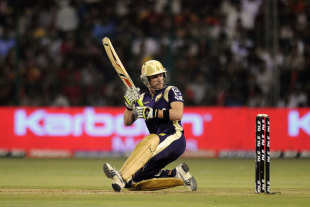
| |||
Big picture
They have one of the world's fastest bowlers (Brett Lee); they have the most destructive batsman behind Chris Gayle in world cricket (Brendon McCullum); they have the most dependable batsman in all formats (Jacques Kallis); they have the world's best allrounder in ODIs (Shakib Al Hasan). And they are one of the most popular teams in the IPL, run by owners who rarely intrude on the team management. Probably, Kolkata are most balanced team in the IPL.
After the controversies and shenanigans in the initial years involving Sourav Ganguly's stubbornness and John Buchannan's radical coaching methods, Kolkata appeared more settled last year with a new captain in Gautam Gambhir. Dav Whatmore has left to coach Pakistan, and a fellow Australian Trevor Bayliss has come in as replacement. Rudi Webster has been hired as a mental skills coach to help youngsters in dealing with high-pressure situations that are frequent in the Twenty20 format. Essentially Kolkata possess the perfect package which could help them progress from the fourth position - their best in the IPL - they finished at last season. The time has come for Kolkata to shed the pretender's role.
Probably they can learn from Mamata Banerjee, the chief minister of West Bengal, the state where the franchise has its home base. Banerjee is known for her ruthlessness, her radical decision-making and her daring - qualities that the team can imbibe if it wants to win the title.
Key players
Jacques Kallis: Consider this: Graeme Smith is South Africa's top run-maker in Twenty20 internationals with 982 runs in 33 matches. Kallis has played half that number (17) but already has 573 runs. In fact, Kallis has more fifties in all-time Twenty20 history barring Brad Hodge - 23 against Hodge's 29. After the franchise bought him at the auction last year, Kallis repaid the owners by finishing as the team's highest run-maker. At 36, Kallis plays with the hunger of a rookie. His durability at the top of the order, his gift to combine patience with aggression, along with his nifty medium-fast bowling, make Kallis not only a go-to man but also one of the most dangerous players.
Gautam Gambhir: Gambhir's Test career as an opener might be facing a crisis, but in the shorter formats Gambhir is a force to reckon with and is India's top scorer in Twenty20 internationals. Last year, Gambhir was uncertain about opening along with Kallis, and might face the same problem with the inclusion of Brendon McCullum, but he could be the perfect No.3, a position from where he can not only anchor the innings and give it a right direction for the big-hitters to flourish at the end. The stakes are high for Gambhir: after being deposed as India vice-captain, he would like to let his performances catapult him back into the leadership role.
Yusuf Pathan: The IPL website has an illustration depicting Yusuf diving forward to take a catch while a banner floating on his back reads Pathan Palkhi (the Pathan palanquin). Indeed, Yusuf's broad shoulders and broad bat can carry his team's burden without breaking much sweat. But last year, Yusuf's influence was barely visible considering he would walk in at the fag end of the innings. He was then out of the Indian team due to poor form. Just like Gambhir, it is redemption time for Yusuf - to come out and play the role of the impact player and elevate himself back into the national reckoning.
Big names in
Brendon McCullum: It was McCullum who lit the IPL dynamite in 2008 with a blitzkrieg century (158 not out) in the tournament's inaugural match in Bangalore. He was bought by the now defunct Kochi franchise last year, but McCullum - Twenty20 international cricket's highest scorer (in fact he is the third highest run-getter in Twenty20 history) - is back to Kolkata and is likely to double up as a wicketkeeper in addition to walking in as an opener.
Trevor Bayliss (coach): Bayliss was Sri Lanka's coach in the 2011 World Cup when the team lost in the final to India and has replaced fellow Australian Dav Whatmore, who is now Pakistan's coach.
Big names out
There remains a questions mark over the availability of Australia wicketkeeper batsman Brad Haddin, who has decided to take time off cricket to resolve some personal issues.
Below the radar
Sunil Narine Sunil Narine turned heads last year when he came to India with the Trinidad & Tobago to play in the Champions League Twenty20. The talent, the trickery in his offspin made coaches and teams wanting him on their roaster. Kolkata paid a handsome $700,000 to buy Narine in a stiff competition with rival franchises. Narine, who bowled impressively under pressure in the two Powerplays in his debut ODI against India last year in Ahmedabad (the only match West Indies won on their tour), finished as the highest wicket-taker in the recent drawn ODI series at home against Australia. Kolkata would hope Narine brings his current form against Australia to the IPL when he lands in May.
Iqbal Abdulla Abdulla won the IPL award for the best young bowler with his allround skills. A left-arm spinner, Abdulla was utilised smartly by Gambhir during pressure situations and the Mumbai player did not disappoint. Coupled with his good fielding and thrifty batting skills, Abdulla can once again play a leading role for Kolkata.
Availability
The only problem for Narine could be his availability with the first half of the IPL clashing with West Indies' Test series against Australia.
* Stats only for teams playing this year's IPL
IPL 2012
Dravid leads stronger batting unit
Cricket +
Big picture
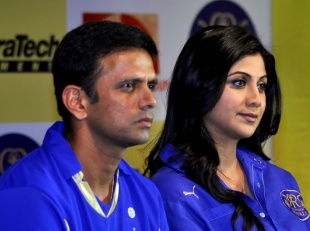
| |||
The key to Rajasthan Royals' 2012 season will be how they handle the transition at the head of the team. Shane Warne, their inspirational captain and face of the franchise, retired. The man who succeeded Warne is a cricket icon of equal standing but of different temperament. Warne was loud, aggressive and loved being the centre of attention. Rahul Dravid is quiet, restrained and simply goes about his business.
What the two have in common though is the ability to lead by example and a deep knowledge of the game. Now that Dravid has retired from international cricket the IPL is his sole cricketing focus, and if anyone can manage the change in culture with as few hiccups as possible, it will be him.
Last season was a mixed bag for the Royals, who started strongly and were in contention for a place in the playoffs before fading towards the end. A controversy over the pitch at the Sawai Mansingh Stadium, which resulted in the disciplining of Warne, was a distraction, but the side's slide exposed the lack of depth in their batting. To the Royals' credit, they have gone some way to address that weakness with the additions of Brad Hodge, Owais Shah and Dinesh Chandimal, who can double up as wicketkeeper and might prove to be the steal of the 2012 player auction.
The loss of Warne will also be felt by the bowling attack, and the team will be hoping Brad Hogg, who had success in the Big Bash and the Bangladesh Premier League, can at least partially fill the void. Sreesanth potentially bolsters the seam department, but he hasn't played competitive cricket for six months and is unpredictable.
Key players
Johan Botha was a revelation up the order in 2011 and his unexpected form with the bat was crucial to the Royals' early success. He also opened the bowling to great effect and the team will need more of the same from him to compete this year.
Warne was one of two players retained by the Royals in 2011. The other was Shane Watson. The Australia allrounder will only arrive at the end of April, after the tour of the West Indies, but if the Royals can get off to a good start in his absence, Watson could provide a crucial late spark to help them qualify for the playoffs.
Big names in
The Royals bought Chandimal, Sri Lanka's newest batting sensation, for only $50,000 at the auction. They needed a wicketkeeper who can bat and they got him cheap. Chandimal's ability and consistency was on show in the recent triangular series in Australia and he should add steel to the Royals middle order.
Big names out
Ross Taylor, the team's self-described "finisher", was traded to Delhi Daredevils on the last day of the trading window. Taylor had a decent tournament in 2011 without producing anything special, and the franchise quickly found a replacement in Shah.
Below the radar
A transformed Stuart Binny was Karnataka's go-to man in the Ranji Trophy last season as the allrounder reaped the benefits of a new attitude and a commitment to fitness. He made 742 runs at an average of 67.45 and a strike rate of 83.46. He also took 20 wickets at an average of 20.10. If Binny can bring the same attitude to the IPL, the Royals might not miss Watson as much during the first half of the tournament.
Availability
Australia's ongoing tour of the West Indies means Watson is unavailable until the Test series ends on April 27.
IPL 2012
Star-studded Delhi look for turnaround
Sharda Ugra
April 3, 2012
Text size: A | A
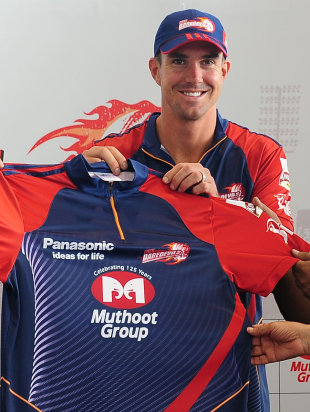
| |||
Related Links
Players/Officials: Unmukt Chand | Mahela Jayawardene |Morne Morkel | Kevin Pietersen | Virender Sehwag | Roelof van der Merwe | David Warner
Series/Tournaments: Indian Premier League
Teams: Delhi Daredevils | India
| |||
Big Picture
Constant revival is the historical motif of the Daredevils' home city, but a more contemporary representation of Delhi would include high speed and road rage. Season five of IPL for the Daredevils will then naturally require not only brazen overtaking over hairpin bends, but navigational acumen to arrive at their destination.
To finish at the bottom in 2011 after topping the table two years ago is evidence that what was previously fixed, had been broken. The Daredevils ended up with only four wins from 14 matches, trailing even the season's two new teams. Maybe rejigging of the team after the auction caused the imbalance or maybe it was a brittle top order.
Regardless of the explosive pair of Virender Sehwag and David Warner, the Daredevils' opening partnership crossed 50 only three times in 14 innings, and it lacked an energetic middle order to carry on after repeated early setbacks. Their season opened with a home game in which the Daredevils were all out for 95 and of their four victories, only one was to come at home. By the end of the season, the Daredevils were left in shambles.
The repair work for the new season has come in the form of the arrival of two quality middle-order men, Kevin Pietersen, who was brought in from Deccan Chargers, and Mahela Jayawardene, to follow the openers.
Had Morne Morkel not broken Ross Taylor's arm in Wellington, the Daredevils' middle order would have had the perfect mix: batsmen of calibre combining with the game's leading entertainers. Morkel himself leads a quick bowling attack with several options, and the presence of Indians among them gives the Daredevils room for flexibility. Along with New Zealand's Doug Bracewell, who will get his first taste of Indian conditions, and West Indian allrounder Andre Russell, the Daredevils will also field a genuinely quick and now toughened Umesh Yadav. The experience of Irfan Pathan and Ajit Agarkar is valuable and Varun Aaron is said to be recovering from the injury that he picked up last year.
Team mentor T A Sekhar who has been signed on again, after a couple of years with the Mumbai Indians, believes that the general gloom about the Daredevils' lack of slow-bowling options is largely baseless. Twenty20 specialist spinning allrounder Roelof van der Merwe comes with more than useful promise.
Along with its eye-catching star cast, a surprise performance from the Daredevils' second line will be a bonus: whether through Australian allrounder Glen Maxwell, who scored a fifty off 17 balls, a record in Australia's List-A or teenager Unmukt Chand, who is leading the India under-19 team in Australia during a two-week tour. The formula of a successful team, says Sekhar, comes from a high-profile core of performers and a handy supporting cast arranged around them.
Key players
Virender Sehwag: He was the only player the Daredevils wanted to retain in 2010, he is the captain from the 2008 'icon' bunch still standing and he remains the team's centrifugal force. He will be energised not only by the presence of many shot-makers around him, but by the quality all the way down to No. 6. Still, it will be Sehwag who will need to set the tone for how the Daredevils' campaign turns out, especially, if he can get them to better starts than last year.
Mahela Jayawardene: After Pietersen, the highest signing by the Daredevils from the 2012 auction, Jayawardene finds himself in his third IPL team in five years after being an asset for any franchise and a tough man to let go of. He found himself in the auction only because Kochi Tuskers Kerala got booted out of the IPL and will arrive into a set up that can do with his reassuring presence in the midst of extravagant talents. If he's not worn out by Sri Lanka's unending travels, Jayawardene can be the improvisational middle-order man who keeps his head when the big hitters go into turbo mode. His calmness at the crease belies his strike rate. His nous on the field will be of assistance to Sehwag's leadership and he was quickly named as the vice-captain.
Big names in
Kevin Pietersen: Who else? The Daredevils were willing to spend up to half of their auction purse - $2.3m in fact - on signing Pietersen from Deccan Chargers in the January transfer window. The signing comes with the hope that Pietersen will become the Daredevils' talisman like Chris Gayle for Bangalore. In theory, Pietersen and the IPL are made for each other - the attention-grabbing performer and the big-ticket stage. His record in the tournament though, is most unlike the man: modest. There's far too few runs - 329 with two half-centuries - in 13 matches, despite having belonged to the bling-filled environment of Royal Challengers Bangalore. But Pietersen will arrive into the IPL after three weeks of acclimatising in Sri Lanka. What awaits him is a team looking for performers in cricket's biggest showboat. It's a match made in heaven.
Andre Russell: Russell has pace, aggression, athleticism and star quality. Yet to prove himself internationally in the shortest form of the game, he has fitted well into the West Indies ODI squad and caught the eye when playing India in eight ODIs last year just after the World Cup. At the domestic level though, he has come to terms with the curious demands of Twenty20, churning out runs at a strike rate of 148. He has played in the Bangladesh Premier League for the Chittagong Kings, but now comes the big stuff. Over the next six weeks, Russell will have a chance to prove that he is cut out for cricket's most lucrative event, the IPL, and therefore, worthy of a $450,000 pay cheque.
Big names out
James Hopes brought optimism when he was inducted into the Daredevils side. He was every inch an allrounder needed by a Twenty20 franchise - a bustling batsman anywhere in the order with handy medium-pace. Last season for the Daredevils though, Hopes played in ten games without producing the high-impact returns expected from him. In exchange for Hopes and Ashok Dinda, both players traded in with the Pune Warriors, the Daredevils had enough cash in hand to sign Pietersen onto their rolls.
Below the radar
Irfan Pathan: Irfan Pathan will always have his days, like his bigger hitting elder brother Yusuf. Now that injuries are behind him and he has had a satisfactory domestic season for Baroda, the Daredevils will hope for bigger performances from him. If things are going for Irfan with the bat, he can unleash a late charge or a recovery. When the ball is swinging, he has what is needed to disturb batsmen and check the flood of runs. If a player is only as good as his last game, then Irfan's produced quite a signal: an allround performance in theSyed Mushtaq Ali Trophy final against Punjab that helped Baroda win the title.
Availability
David Warner will turn up in May after the end of Australia's tour of the West Indies and Ross Taylor, when he has recuperated from his injury. Varun Aaron is building up towards recovery and should be ready by the third week. Unmukt Chand will be back from Australia in the second week but if he gets a game, he will have to make it count.
2011 in a tweet
Two semi-finals and a fifth-place finish followed by a crash landing. Law of averages be damned.IPL 2012
Star-studded Delhi look for turnaround
Cricket +

| |||
Related Links
Players/Officials: Unmukt Chand | Mahela Jayawardene |Morne Morkel | Kevin Pietersen | Virender Sehwag | Roelof van der Merwe | David Warner
Series/Tournaments: Indian Premier League
Teams: Delhi Daredevils | India
| |||
Big Picture
Constant revival is the historical motif of the Daredevils' home city, but a more contemporary representation of Delhi would include high speed and road rage. Season five of IPL for the Daredevils will then naturally require not only brazen overtaking over hairpin bends, but navigational acumen to arrive at their destination.
To finish at the bottom in 2011 after topping the table two years ago is evidence that what was previously fixed, had been broken. The Daredevils ended up with only four wins from 14 matches, trailing even the season's two new teams. Maybe rejigging of the team after the auction caused the imbalance or maybe it was a brittle top order.
Regardless of the explosive pair of Virender Sehwag and David Warner, the Daredevils' opening partnership crossed 50 only three times in 14 innings, and it lacked an energetic middle order to carry on after repeated early setbacks. Their season opened with a home game in which the Daredevils were all out for 95 and of their four victories, only one was to come at home. By the end of the season, the Daredevils were left in shambles.
The repair work for the new season has come in the form of the arrival of two quality middle-order men, Kevin Pietersen, who was brought in from Deccan Chargers, and Mahela Jayawardene, to follow the openers.
Had Morne Morkel not broken Ross Taylor's arm in Wellington, the Daredevils' middle order would have had the perfect mix: batsmen of calibre combining with the game's leading entertainers. Morkel himself leads a quick bowling attack with several options, and the presence of Indians among them gives the Daredevils room for flexibility. Along with New Zealand's Doug Bracewell, who will get his first taste of Indian conditions, and West Indian allrounder Andre Russell, the Daredevils will also field a genuinely quick and now toughened Umesh Yadav. The experience of Irfan Pathan and Ajit Agarkar is valuable and Varun Aaron is said to be recovering from the injury that he picked up last year.
Team mentor T A Sekhar who has been signed on again, after a couple of years with the Mumbai Indians, believes that the general gloom about the Daredevils' lack of slow-bowling options is largely baseless. Twenty20 specialist spinning allrounder Roelof van der Merwe comes with more than useful promise.
Along with its eye-catching star cast, a surprise performance from the Daredevils' second line will be a bonus: whether through Australian allrounder Glen Maxwell, who scored a fifty off 17 balls, a record in Australia's List-A or teenager Unmukt Chand, who is leading the India under-19 team in Australia during a two-week tour. The formula of a successful team, says Sekhar, comes from a high-profile core of performers and a handy supporting cast arranged around them.
Key players
Virender Sehwag: He was the only player the Daredevils wanted to retain in 2010, he is the captain from the 2008 'icon' bunch still standing and he remains the team's centrifugal force. He will be energised not only by the presence of many shot-makers around him, but by the quality all the way down to No. 6. Still, it will be Sehwag who will need to set the tone for how the Daredevils' campaign turns out, especially, if he can get them to better starts than last year.
Mahela Jayawardene: After Pietersen, the highest signing by the Daredevils from the 2012 auction, Jayawardene finds himself in his third IPL team in five years after being an asset for any franchise and a tough man to let go of. He found himself in the auction only because Kochi Tuskers Kerala got booted out of the IPL and will arrive into a set up that can do with his reassuring presence in the midst of extravagant talents. If he's not worn out by Sri Lanka's unending travels, Jayawardene can be the improvisational middle-order man who keeps his head when the big hitters go into turbo mode. His calmness at the crease belies his strike rate. His nous on the field will be of assistance to Sehwag's leadership and he was quickly named as the vice-captain.
Big names in
Kevin Pietersen: Who else? The Daredevils were willing to spend up to half of their auction purse - $2.3m in fact - on signing Pietersen from Deccan Chargers in the January transfer window. The signing comes with the hope that Pietersen will become the Daredevils' talisman like Chris Gayle for Bangalore. In theory, Pietersen and the IPL are made for each other - the attention-grabbing performer and the big-ticket stage. His record in the tournament though, is most unlike the man: modest. There's far too few runs - 329 with two half-centuries - in 13 matches, despite having belonged to the bling-filled environment of Royal Challengers Bangalore. But Pietersen will arrive into the IPL after three weeks of acclimatising in Sri Lanka. What awaits him is a team looking for performers in cricket's biggest showboat. It's a match made in heaven.
Andre Russell: Russell has pace, aggression, athleticism and star quality. Yet to prove himself internationally in the shortest form of the game, he has fitted well into the West Indies ODI squad and caught the eye when playing India in eight ODIs last year just after the World Cup. At the domestic level though, he has come to terms with the curious demands of Twenty20, churning out runs at a strike rate of 148. He has played in the Bangladesh Premier League for the Chittagong Kings, but now comes the big stuff. Over the next six weeks, Russell will have a chance to prove that he is cut out for cricket's most lucrative event, the IPL, and therefore, worthy of a $450,000 pay cheque.
Big names out
James Hopes brought optimism when he was inducted into the Daredevils side. He was every inch an allrounder needed by a Twenty20 franchise - a bustling batsman anywhere in the order with handy medium-pace. Last season for the Daredevils though, Hopes played in ten games without producing the high-impact returns expected from him. In exchange for Hopes and Ashok Dinda, both players traded in with the Pune Warriors, the Daredevils had enough cash in hand to sign Pietersen onto their rolls.
Below the radar
Irfan Pathan: Irfan Pathan will always have his days, like his bigger hitting elder brother Yusuf. Now that injuries are behind him and he has had a satisfactory domestic season for Baroda, the Daredevils will hope for bigger performances from him. If things are going for Irfan with the bat, he can unleash a late charge or a recovery. When the ball is swinging, he has what is needed to disturb batsmen and check the flood of runs. If a player is only as good as his last game, then Irfan's produced quite a signal: an allround performance in theSyed Mushtaq Ali Trophy final against Punjab that helped Baroda win the title.
Availability
David Warner will turn up in May after the end of Australia's tour of the West Indies and Ross Taylor, when he has recuperated from his injury. Varun Aaron is building up towards recovery and should be ready by the third week. Unmukt Chand will be back from Australia in the second week but if he gets a game, he will have to make it count.
2011 in a tweet
Two semi-finals and a fifth-place finish followed by a crash landing. Law of averages be damned.IPL 2012
Five overseas signings to watch
Cricket + picks out five overseas players who are on their way up in the international game and likely to make quite an impact in their debut IPL seasons
Cricket +
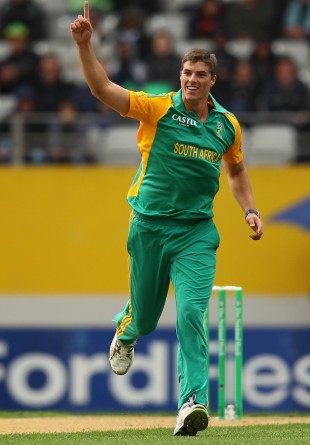
| |||
Richard Levi
The South Africa opening batsman was among several players who went unsold at the auction in Bangalore. He was not an unknown at the time - he toured India with Cape Cobras in last year's Champions League T20. He soon found himself in South Africa's Twenty20 plans, touring New Zealand earlier this year. One knock was enough for the franchises to take notice. At Seddon Park, Hamilton - by no means the biggest ground in the world - Levi smashed a record century off just 45 balls with 13 sixes, the most ever for a Twenty20 innings. Several hits went many rows back, showing that he had the power to clear bigger grounds as well. Sahara Pune Warriors were reportedly interested in him, but he was ultimately picked up by Mumbai Indians as a replacement for Andrew Symonds, who pulled out. Levi hopes to open with Sachin Tendulkar and use this Indian experience to master subcontinent conditions.
The South Africa opening batsman was among several players who went unsold at the auction in Bangalore. He was not an unknown at the time - he toured India with Cape Cobras in last year's Champions League T20. He soon found himself in South Africa's Twenty20 plans, touring New Zealand earlier this year. One knock was enough for the franchises to take notice. At Seddon Park, Hamilton - by no means the biggest ground in the world - Levi smashed a record century off just 45 balls with 13 sixes, the most ever for a Twenty20 innings. Several hits went many rows back, showing that he had the power to clear bigger grounds as well. Sahara Pune Warriors were reportedly interested in him, but he was ultimately picked up by Mumbai Indians as a replacement for Andrew Symonds, who pulled out. Levi hopes to open with Sachin Tendulkar and use this Indian experience to master subcontinent conditions.
Sunil Narine
The Trinidad and Tobago spinner is not a new face to Indian audiences. He emerged from last year's Champions League as one of the players to watch in the future. His stock ball is the offspinner, but he has developed the mystery delivery called the knuckle ball, a variation delivered with a loose wrist and a corkscrew twist of two fingers that makes it grip, turn away from the right hander, and bounce alarmingly. At the Champions League, he confounded Chennai Super Kings on his way to figures of 3 for 8 - a haul that including the wickets of MS Dhoni and Suresh Raina. He's now a regular in West Indies' limited-overs squads and is in the reckoning for the Tests against Australia as well. If picked, Narine could show up for Kolkata Knight Riders only by the end of the month. His base price was US$50,000, but the franchise was willing to fork out US$700,000 to get him.
The Trinidad and Tobago spinner is not a new face to Indian audiences. He emerged from last year's Champions League as one of the players to watch in the future. His stock ball is the offspinner, but he has developed the mystery delivery called the knuckle ball, a variation delivered with a loose wrist and a corkscrew twist of two fingers that makes it grip, turn away from the right hander, and bounce alarmingly. At the Champions League, he confounded Chennai Super Kings on his way to figures of 3 for 8 - a haul that including the wickets of MS Dhoni and Suresh Raina. He's now a regular in West Indies' limited-overs squads and is in the reckoning for the Tests against Australia as well. If picked, Narine could show up for Kolkata Knight Riders only by the end of the month. His base price was US$50,000, but the franchise was willing to fork out US$700,000 to get him.
Marchant de Lange
This soft-spoken South Africa right-arm fast bowler is anything but shy with the ball. It's all raw pace and bounce, as he's capable of bowling consistently at 150kph and above. Kolkata Knight Riders bought him at the auction at his base price of $50,000. A new entrant to international cricket, de Lange showed the touring Australians what he's capable of, nipping out five wickets in a tour game. Some Australia players told Kolkata: "This guy is bowling fireballs". He took seven in an innings on Test debut, making him the most successful Test debutant of 2011. He also showed his temperament in a close Twenty20 against New Zealand in Auckland. With six to defend off the last over, captain AB de Villiers tossed the ball to the inexperienced de Lange. He conceded just three runs and took two wickets in South Africa's heist. Will he be a last-over specialist for Kolkata too?
This soft-spoken South Africa right-arm fast bowler is anything but shy with the ball. It's all raw pace and bounce, as he's capable of bowling consistently at 150kph and above. Kolkata Knight Riders bought him at the auction at his base price of $50,000. A new entrant to international cricket, de Lange showed the touring Australians what he's capable of, nipping out five wickets in a tour game. Some Australia players told Kolkata: "This guy is bowling fireballs". He took seven in an innings on Test debut, making him the most successful Test debutant of 2011. He also showed his temperament in a close Twenty20 against New Zealand in Auckland. With six to defend off the last over, captain AB de Villiers tossed the ball to the inexperienced de Lange. He conceded just three runs and took two wickets in South Africa's heist. Will he be a last-over specialist for Kolkata too?
Doug Bracewell
This right-arm fast bowler was one of New Zealand's finds of the season. The nephew of former national coach John Bracewell, Doug Bracewell took a five-for on Test debut in Zimbabwe, but his match haul of 9 for 60 in a winning cause in Hobart is a performance he will never forget. It took a rookie to break New Zealand's Test jinx against Australia. Delhi Daredevils bought him for his base price of $50,000. He has pace, hits the deck hard and is a capable lower-order batsman. He took nine wickets in eight games for Central Districts in the Twenty20 HRV Cup in New Zealand.
This right-arm fast bowler was one of New Zealand's finds of the season. The nephew of former national coach John Bracewell, Doug Bracewell took a five-for on Test debut in Zimbabwe, but his match haul of 9 for 60 in a winning cause in Hobart is a performance he will never forget. It took a rookie to break New Zealand's Test jinx against Australia. Delhi Daredevils bought him for his base price of $50,000. He has pace, hits the deck hard and is a capable lower-order batsman. He took nine wickets in eight games for Central Districts in the Twenty20 HRV Cup in New Zealand.
Andre Russell
Delhi Daredevils bought the West Indies allrounder for $450,000 - nine times his base price. Though still a relative newcomer to international cricket, his all-round abilities in limited-overs cricket caught the attention of team owners in Bangladesh and India. Like Chris Gayle and Kieron Pollard, Russell is capable of massive hits - he has a Twenty20 strike-rate of 148.58. He demonstrated that during West Indies' one-day series in India last year - not a bad stage to audition for the IPL. His highest ODI score of 92 also came against India. He bowls at good pace - though not as quick as de Lange - and has variations in his yorkers and slower balls. His athletic fielding was also impressive in the recently-concluded one-day series against Australia. Delhi should have his services all through the tournament, unless he's picked for West Indies' home Tests.
Delhi Daredevils bought the West Indies allrounder for $450,000 - nine times his base price. Though still a relative newcomer to international cricket, his all-round abilities in limited-overs cricket caught the attention of team owners in Bangladesh and India. Like Chris Gayle and Kieron Pollard, Russell is capable of massive hits - he has a Twenty20 strike-rate of 148.58. He demonstrated that during West Indies' one-day series in India last year - not a bad stage to audition for the IPL. His highest ODI score of 92 also came against India. He bowls at good pace - though not as quick as de Lange - and has variations in his yorkers and slower balls. His athletic fielding was also impressive in the recently-concluded one-day series against Australia. Delhi should have his services all through the tournament, unless he's picked for West Indies' home Tests.
IPL 2012
Super Kings the team to beat
A stats review of the four previous IPL seasons
Cricket +
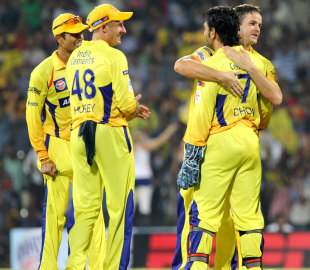
| |||
Related Links
Series/Tournaments: Indian Premier League
Teams: Chennai Super Kings
Grounds: MA Chidambaram Stadium
| |||
With the Twenty20 World Cup to be played later this year in Sri Lanka, this edition of the IPL promises to have a far greater context than the 2011 season of the IPL which started within a week of India's successful World Cup campaign. Chennai Super Kings, who have been the most consistent team across the four seasons, remain favourites for the title. They made the final of the inaugural season in 2007-08, losing by a narrow margin to Shane Warne's Rajasthan Royals. In the next three seasons, Super Kings made one semi-final (2009 in South Africa) and won the last two tournaments. Their top-class record in the IPL can be gauged from their displays in each season. There has not been a single season in which they've lost more matches than they've won. Their overall win-loss ratio across four seasons (1.54) is comfortably ahead of second-placed Mumbai Indians, who have a corresponding value of 1.26.
Super Kings, who defeated Royal Challengers Bangalore in a one-sided final last year, had an outstanding run in the 2011 tournament and finished with a win-loss ratio greater than two (2.20) in the season. For most of the other teams, winning consistently hasn't been as easy. Deccan Chargers, who won the title in 2009, have been less consistent, winning only 25 matches and losing 35. Delhi Daredevils, Kings XI Punjab and Kolkata Knight Riders have all been mediocre throughout and never dominated any season. Royals stunned everybody by winning the title in 2008 while boasting a win-loss ratio of 4.33 (13 wins to three losses). However, since then, their form has deteriorated sharply - they won 17 and lost 22 in the previous three tournaments.
| Team | 2008 | 2009 | 2010 | 2011 | Overall (played, wins/losses, w/l ratio) |
| Super Kings | 9/7, 1.28 | 8/6, 1.33 | 9/6, 1.50 | 11/5, 2.20 | 62, 37/24, 1.54 |
| Indians | 7/7, 1.00 | 5/8, 0.62 | 11/5, 2.20 | 10/6, 1.66 | 59, 33/26, 1.26 |
| Royals | 13/3, 4.33 | 5/7, 0.71 | 6/8, 0.75 | 6/7, 0.85 | 56, 30/25, 1.20 |
| Royal Challengers | 4/10, 0.40 | 9/7, 1.28 | 8/8, 1.00 | 10/6, 1.66 | 62, 31/31, 1.00 |
| Daredevils | 7/7, 1.00 | 10/5, 2.00 | 7/7, 1.00 | 4/9, 0.44 | 57, 28/28, 1.00 |
| Kings XI | 10/5, 2.00 | 7/7, 1.00 | 3/10, 0.30 | 7/7, 1.00 | 57, 27/29, 0.93 |
| Knight Riders | 6/7, 0.85 | 3/9, 0.33 | 7/7, 1.00 | 8/7, 1.14 | 55, 24/30, 0.80 |
| Chargers | 2/12, 0.16 | 9/7, 1.28 | 8/8, 1.00 | 6/8, 0.75 | 60, 25/35, 0.71 |
| Warriors | - | - | - | 4/9, 0.44 | 14, 4/9, 0.44 |
Super Kings' domination is reflected in the batting and bowling stats. Their run rate has always been ahead of their economy rate in each of the seasons and the difference between the two (run-rate difference) was as high as 0.51 in 2012. Chargers finished with a low economy rate (7.52) in 2009, when they won the title and maintained a positive run-rate difference, but struggled to do the same consistently since then. Indians, who also have an excellent record overall in the IPL, have a positive run-rate difference in all four seasons, with their best run coming in the 2010 season (difference of 0.80), when they lost in the finals to Super Kings. However, from the table, it is easy to observe that all teams had low run rates and economy rates in 2009, when the tournament was played in South Africa.
| Team | 2008 | 2009 | 2010 | 2011 | Overall |
| Super Kings | 8.44/8.42 | 8.10/7.54 | 8.33/7.94 | 8.13/7.62 | 8.25/7.89 |
| Chargers | 8.29/8.70 | 7.90/7.52 | 7.62/8.03 | 7.66/7.56 | 7.86/7.93 |
| Daredevils | 8.48/8.34 | 7.73/7.54 | 7.92/7.85 | 7.84/8.34 | 7.98/8.00 |
| Kings XI | 8.81/8.54 | 7.19/7.58 | 8.26/8.73 | 8.10/8.43 | 8.10/8.34 |
| Knight Riders | 7.79/8.05 | 7.20/7.87 | 7.87/8.19 | 7.51/7.26 | 7.60/7.82 |
| Indians | 8.34/8.05 | 7.40/7.23 | 8.63/7.83 | 7.54/7.48 | 7.96/7.65 |
| Warriors | - | - | - | 7.24/7.24 | 7.24/7.24 |
| Royals | 8.74/7.89 | 6.82/7.02 | 8.13/8.59 | 7.15/7.65 | 7.77/7.79 |
| Royal Challengers | 7.43/8.42 | 7.35/7.51 | 8.16/7.95 | 8.40/8.07 | 7.83/7.97 |
Barring 2009, all other tournaments have been high scoring ones. The inaugural tournament in 2008 comprised 58 matches and the run rate was 8.30 with an average run-per-match figure of 309.25. However, in South Africa, both these values dropped to 7.48 and 286.31. A significant dip is also observed in the boundary-run percentage, which fell from 58.76 in 2008 to 50.85 in 2009. The average wickets-per-match figure in 2009 (12.2) is also higher than all other tournaments, which is indicative of the bowler-friendly conditions in South Africa. In 2010, when the IPL moved back to India, the average run-per-match figure shot back up to 314.40 but the boundary-run percentage in 2010 (54.84) was not as high as in the previous tournament in India. The 2011 tournament had a lower run-rate (7.72) than both the 2008 and 2010 tournaments and also a low value of average runs-per-match (289.78), which is better only when compared to the 2009 tournament. The 2008 and 2010 editions also had the highest number of fifties per match (1.53). The tournament held in South Africa (2009) finished bottom on this scale as well - 1.22.
| Season | Country | Matches | RPO/RPW | Runs/match | Boundary % | Boundary runs/match | 50-plus scores/match | Wickets/match |
| 2008 | India | 58 | 8.30/26.03 | 309.25 | 58.76 | 181.72 | 1.53 | 11.87 |
| 2009 | South Africa | 57 | 7.48/23.41 | 286.31 | 50.85 | 145.61 | 1.22 | 12.22 |
| 2010 | India | 60 | 8.12/26.20 | 314.40 | 54.84 | 172.43 | 1.53 | 12.00 |
| 2011 | India | 73 | 7.72/26.01 | 289.78 | 54.29 | 157.34 | 1.30 | 11.13 |
| Overall | India/South Africa | 248 | 7.90/25.44 | 299.49 | 54.75 | 164 | 1.39 | 11.77 |
A comparison of the run rates and boundary percentages across the different phases of an innings has interesting results. In the first six-over period, the run rate in the 2010 tournament (7.89) is the highest, followed by 2008, when it was 7.70. The boundary percentage in 2008 (66.70) is the highest among all tournaments while the lowest figure is surprisingly in the 2011 tournament (62.80). Although the 2011 tournament was held in India, the run rate in the first-six over period was the lowest (7.20). The boundary-run percentage in the middle-over period (overs 7-14) in 2008 is much higher than the corresponding numbers in the other tournaments. The averages are generally higher in the middle overs owing to a slightly more conservative approach by batsmen during this period. The run rate in the final overs (overs 15-20) is the highest in 2008 (9.75) and has been over nine in all seasons except 2009, when the figure was marginally lower (8.91).
| Phase of innings | 2008 | 2009 | 2010 | 2011 | Overall |
| Overs 1-6 | 7.70/30.44, 66.70 | 7.22/26.37, 63.89 | 7.89/32.28, 65.50 | 7.20/29.82, 62.80 | 7.49/29.68, 64.37 |
| Overs 7-14 | 7.87/31.69, 51.75 | 6.72/26.39, 40.41 | 7.54/28.41, 45.97 | 7.30/32.12, 47.57 | 7.36/29.95, 46.70 |
| Overs 15-20 | 9.75/18.94, 60.32 | 8.91/18.48, 50.67 | 9.24/20.56, 55.35 | 9.01/19.09, 54.88 | 9.21/19.26, 55.31 |
The spinners did not have much of an impact in the first season of the IPL, taking 134 wickets while the fast bowlers picked up 445. The spinners also had a slightly higher average and economy rate in 2008 compared to the quicks. However, in the second season (2009), the percentage contribution of wickets for spinners went up. Not only were the averages and economy rates lower for spinners, but the figures for boundary percentage and dot-ball percentage were also better than those for the pace bowlers. In the 2010 and 2011 season, the economy rates for spinners (7.34 and 7.12) were considerably better than those of pace bowlers. Overall, across the four seasons, pace bowlers have picked up more than twice the number of wickets that spinners have. However, spinners have better values of economy rate, average and boundary-run percentage.
| Season | Pace (wickets/avg, econ rate) | Pace (dot-ball%/ boundary%) | Spin (wickets/avg, econ rate) | Spin (dot-ball%/ boundary%) |
| 2008 | 445/29.23, 8.09 | 41.18/61.60 | 134/30.38, 8.19 | 35.79/56.20 |
| 2009 | 388/26.25, 7.65 | 42.95/57.24 | 226/24.77, 6.76 | 37.33/42.68 |
| 2010 | 405/29.64, 8.32 | 38.34/59.17 | 210/28.80, 7.34 | 36.94/50.41 |
| 2011 | 470/28.12, 7.80 | 41.04/58.32 | 267/27.66, 7.12 | 38.56/50.73 |
| Overall | 1708/28.34, 7.97 | 40.86/59.18 | 837/27.60, 7.25 | 37.39/49.66 |
Except for the occasional low-scoring match, most games in the IPL have been run fests. Teams scored over 200 on 17 occasions while batting first, and have also managed chases of 180-plus targets 13 times. Chennai, the home ground of the defending champions, Super Kings, has had the average runs-per-match figure drop from a high of 333.71 in 2008 to 313.44 in 2011. The run-rate, which was 8.52 in 2008, fell to 7.86 in 2011 and the average run-rate across the three seasons is 8.17. The Eden Gardens in Kolkata has generally been a difficult venue to score on and this is reflected in the low values of run-rate and average runs-per-match across the three seasons. Bangalore and Mohali have been high-scoring venues with the latter in particular having a high value of runs-per-match (330.75) and run-rate (8.51) across the three tournaments.
| Venue | 2008 | 2010 | 2011 | Overall |
| Chennai | 7/333.71, 28.83/8.52 | 7/318.00, 27.14/8.21 | 9/313.44, 27.12/7.86 | 23/321.00, 27.65/8.17 |
| Kolkata | 7/263.28, 22.20/7.36 | 7/309.57, 30.95/8.00 | 7/264.85, 25.75/7.28 | 21/279.23, 26.06/7.55 |
| Delhi | 6/325.16, 30.96/9.11 | 7/309.86, 22.36/7.98 | 7/269.14, 25.45/7.87 | 20/300.20, 25.65/8.28 |
| Bangalore | 7/291.71, 22.94/7.79 | 7/323.43, 30.59/8.51 | 6/274.66, 27.46/7.65 | 20/297.70, 26.69/8.01 |
| Jaipur | 7/302.28, 24.32/7.95 | 3/294.33, 28.48/7.97 | 7/277.71, 28.17/7.32 | 17/290.76, 26.43/7.70 |
| Mohali | 7/350.42, 30.28/8.93 | 5/325.40, 26.24, 8.23 | 4/303.00, 22.86/8.12 | 16/330.75, 27.00/8.51 |
| Mumbai | 6/277.33, 23.11/8.10 | 0 | 9/302.33, 28.05/7.81 | 15/292.33, 25.94/7.91 |
| Hyderabad | 7/342.00, 28.84/8.86 | 0 | 7/311.14, 27.56/7.95 | 14/326.57, 28.22/8.40 |

WOW!!!
ReplyDeleteVery Nice information news related to Cricket news, IPL 2012 News, ICC Ranking and more news.